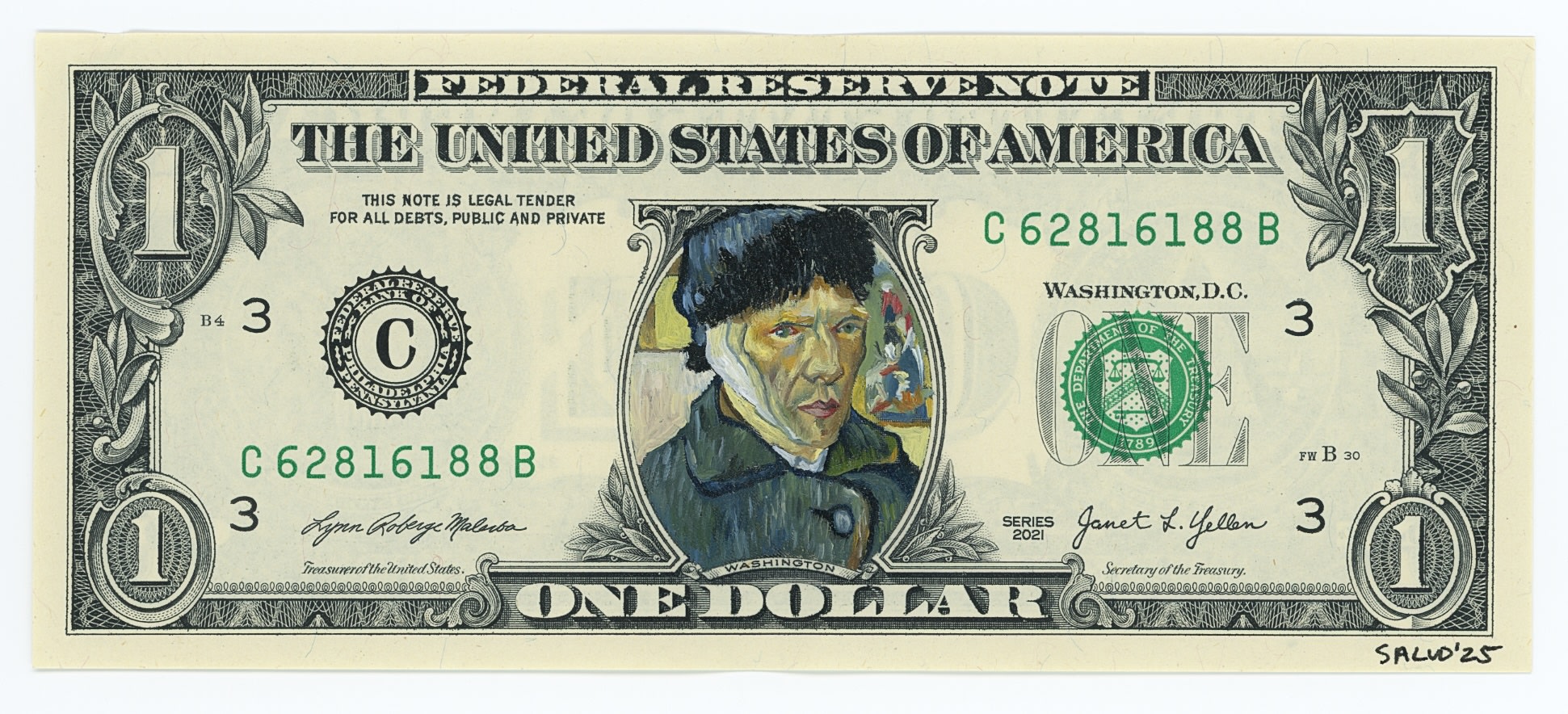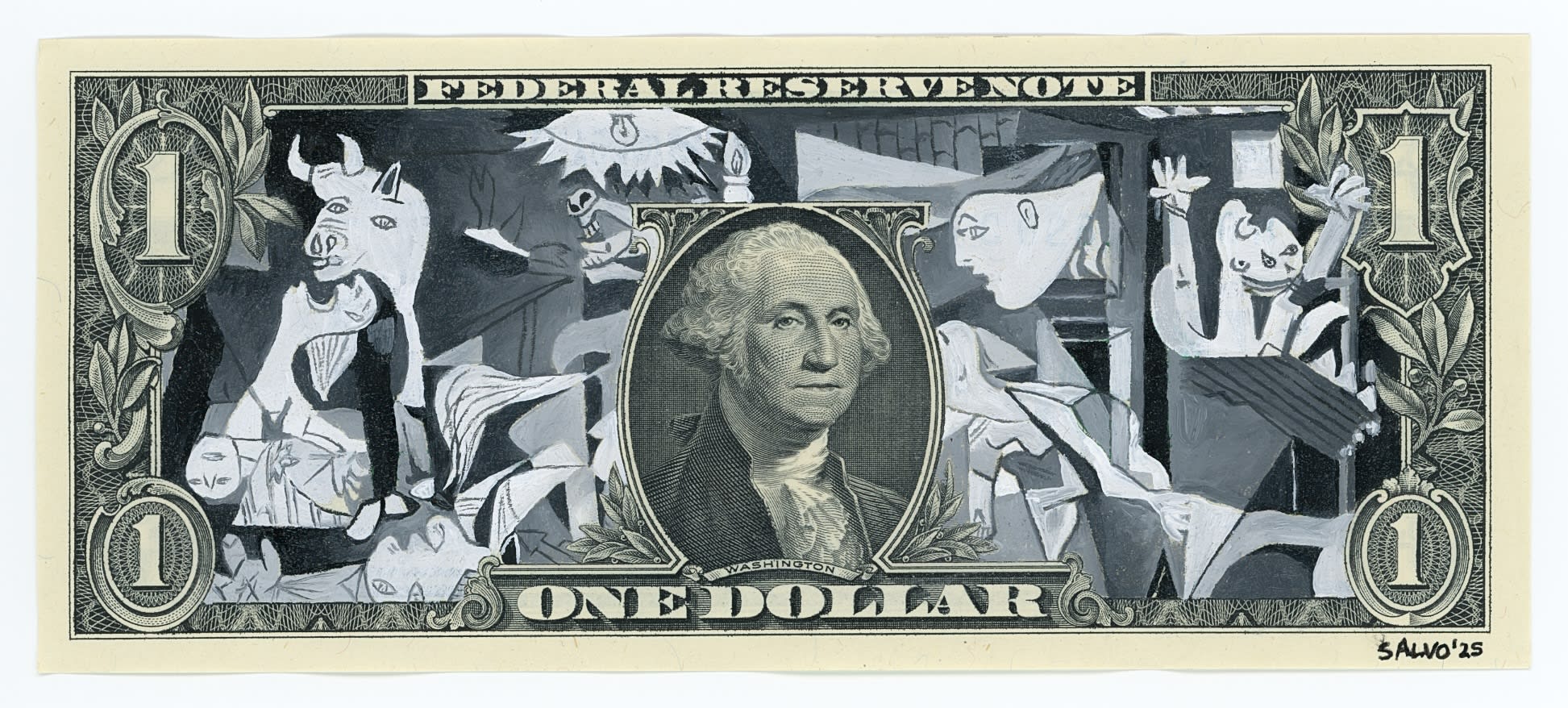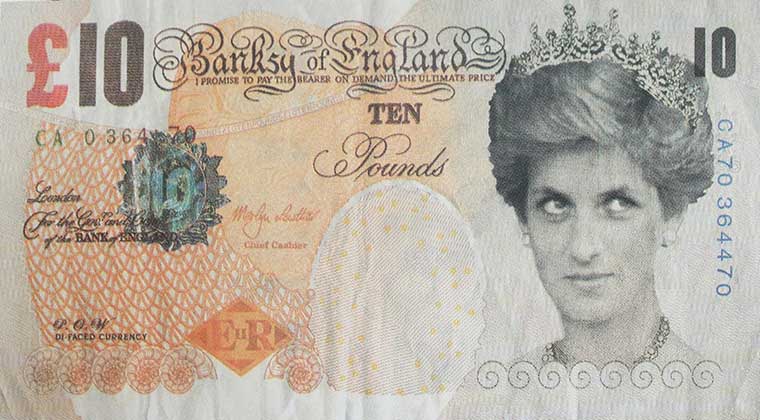Claire Salvo has built a rare bridge between two worlds that don't always speak fluently to one another: the hyper-speed attention economy of social media and the slower, trust-based ecosystem of the emerging art market. Her vehicle is as audacious as it is disarmingly familiar - the U.S. dollar bill. By painting directly onto legal tender with meticulous acrylic technique, Salvo converts the most ubiquitous symbol of value into a compact stage for art history, representation, and cultural critique. The result is a practice that is instantly legible on a phone screen yet rigorous enough to reward close, in-person viewing - an ideal formula for contemporary visibility and collectability.
Salvo began as a portraitist with a realist bent - precise brushwork, finely tuned color, and an instinct for likeness at unusual scales. The turn to currency wasn't a gimmick; it was a conceptual puzzle that aligned with her strengths. A dollar bill offers strict constraints - size, existing imagery, ink colors, and security patterns - yet those constraints provide compositional anchors. Washington's oval becomes a frame or a foil; the word "ONE" becomes a visual weight; the green seal becomes a chromatic counterpoint. Salvo's subjects ranging from pop culture symbols to art historical icons - operate as homages and arguments, compressing "big art" into the palm of your hand.

Currency is a consensus fiction we agree to believe; it is state-backed symbolism distilled. Painting on it lets Salvo ask who we honor, what we consider valuable, and how cultural memory gets minted.
Cotton-linen rag paper, micro-printing, serial numbers, and seals force the painting to negotiate - not overwrite - the bill's structure. Her best works feel interlocked with the design rather than pasted on top of it.
The bill's small size demand close looking; the viewer must step in, a gesture that creates personal connection and makes the work ideal for both online and physical display.

Salvo's rise on social media illustrates how platform fluency can accelerate an art career when matched by genuine craft. Short time-lapse videos show Washington morphing into Cardi B or Frida Kahlo in seconds - perfectly suited to mobile viewing.
The point isn't virality for its own sake; it's that a strong social layer gives early evidence of demand and creates repeat collectors who track new series over time.

Salvo sits in a sweet spot for contemporary collecting: clear authorship, repeatable yet varied series logic, and price points that allow new collectors to enter while leaving room for growth. Key features of her market position:
-
The painted dollar bill is instantly identifiable and technically hard to imitate well.
-
The "Art History" works create a narrative spine - collectors can build sets (e.g., "Masters," "Surrealists," "Impressionists") while every piece remains unique.
-
The works attract fine-art buyers, design lovers, and pop-culture collectors alike, deepening liquidity.
-
Professionally floated and framed, the bills command surprising presence on the wall - critical for converting online interest to offline acquisitions.
Salvo's practice belongs to a long, inventive conversation about currency as image and object.
-
Warhol's Dollar Signs: Andy Warhol made the money symbol itself a motif - gaudy, serial, and self-aware - collapsing the distance between subject and market. The paintings suggest desire and reproducibility, treating value as a pop icon.

-
Banksy's Di-faced Tenners: Banksy spoofed British banknotes by replacing the Queen with Princess Diana and altering text, distributing them during events so they briefly circulated as "real." It tested trust in money's image and the ethics of authorship.

-
Conceptual and Fluxus precedents: From Joseph Beuys's stamped currency to J.S.G. Boggs's hand-drawn "Boggs bills," artists have long used money to question legitimacy, exchange, and authorship.
Salvo integrates art history into the state's design and shifts the conversation from "what money is" to who and what we value.
When viewing Salvo's work, one recognizes the bill and the art reference; the mind locks them together in a single, memorable image.
The paintings hold up under magnification - feathered edges, modulated color, crisp detail - so they aren't reliant on the concept alone.
Handling a framed bill feels both illicit and precious, amplifying the viewer's emotional response.
No artwork is a guaranteed financial instrument, but collectors can evaluate Salvo's market with the same discipline used for any emerging artist.

What to look for:
-
Authenticity and paperwork: Signature and date on the bill, certificate of authenticity, and high-res images
-
Prime examples: Clean integration with the bill's architecture, confident paint handling, and subjects with strong cultural resonance (e.g., canonical artists or landmark works) tend to lead demand.
-
Condition and framing: UV-filter glazing, acid-free float mounts, and humidity control protect the cotton-linen paper. Avoid direct sun.
-
Provenance and placement: Works acquired through reputable galleries, exhibitions, or notable collections retain value better.
Portfolio strategy:
-
Build a focused set (e.g., three to five different "masters") to create a compelling narrative on the wall.
-
Track series milestones - early works, special collaborations, or pieces tied to exhibitions can carry a premium.
-
Keep a long horizon. The strongest returns in emerging markets usually accrue to patient collectors who buy prime examples and support the artist's growth.

Salvo's trajectory is not just a follower count. More telling metrics include consistent sell-through on releases, waiting lists for specific themes, price stability across outlets, thoughtful institutional or press attention, and a secondary market that aligns with (rather than undercuts) primary pricing. These signals suggest durability, not just momentary buzz.
The convergence of clear concept, high craft, platform fluency, and cultural timeliness positions Salvo unusually well in today's market. She doesn't merely depict money; she reassigns it - using the dollar bill to host alternative pantheons, from overlooked pioneers to titans of art history. That gesture is simple enough to travel globally yet deep enough to sustain scholarly interest.
Claire Salvo exemplifies a new kind of artist for a new kind of market: social-first yet studio-serious; collectible at intimate scale yet resonant with big ideas. Her painted bills sit within a historic dialogue about money in art - from Warhol's Dollar Signs to Banksy's Di-faced Tenners - while advancing it in a way that feels precise to our moment.
For collectors, the case is straightforward: choose strong subjects, insist on documentation and professional framing, and think in sets. For everyone else, the works offer a concise, elegant reminder that value is always a picture we agree to share - and that art has the power to redraw it.

